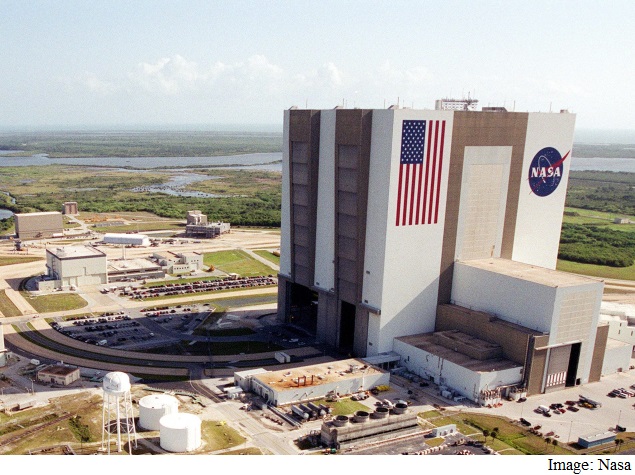- Home
- Science
- Science News
- Nasa Climate Scientists Join Hunt for Alien Earths
Nasa Climate Scientists Join Hunt for Alien Earths

The effort is part of a broader push to identify Earth-like worlds.
"We have to start thinking about these things as more than planetary objects. All of a sudden, this has become a topic not just for astronomers, but for planetary scientists and now climate scientists," said Anthony Del Genio, climate modeller who is leading the GISS effort.
Nasa's space-based Kepler telescope has found more than 1,000 alien planets.
At least five of these planets are similar in size to the Earth and located in the "habitable zone" where liquid water could persist.
The next step would be to detect light passing through exoplanet atmospheres, which could hold clues to conditions on these distant worlds, the scientific journal Nature reported.
Del Genio's group is one of nearly 16 ranging from the Earth and planetary scientists to solar physicists and astrophysicists that are participating in Nasa's new Nexus for Exoplanet System Science (NExSS) programme.
The effort has an initial annual budget of roughly $10-12 million.
"We are bringing together a bunch of different disciplines and they all look at the formation and functioning of planets in different ways," added Mary Voytek who organised NExSS.
NExSS will expand the network of researchers collaborating on exoplanets.
It could also help Nasa develop missions to hunt for exoplanets in the 2020s and beyond.
At GISS, Del Genio's team is creating an exoplanet model that can be adjusted for different planetary systems.
Initial simulations will focus on the Earth's ancient past and the evolution of Venus and Mars.
Although neither can support life today, each may have had liquid surface water at some time.
The team's ultimate goal is to explore the concept of a habitable zone by mixing and matching some of the key factors that determine whether a planet can support life.
"In 15 or 20 years, we might get a spectrum of a planet that looks Earth-like, and then everyone will be out with their models trying to model that planet. I would like it to happen quicker but we need a big telescope," concluded James Kasting, atmospheric scientist at the Pennsylvania State University.
For the latest tech news and reviews, follow Gadgets 360 on X, Facebook, WhatsApp, Threads and Google News. For the latest videos on gadgets and tech, subscribe to our YouTube channel. If you want to know everything about top influencers, follow our in-house Who'sThat360 on Instagram and YouTube.
Related Stories
- Samsung Galaxy Unpacked 2025
- ChatGPT
- Redmi Note 14 Pro+
- iPhone 16
- Apple Vision Pro
- Oneplus 12
- OnePlus Nord CE 3 Lite 5G
- iPhone 13
- Xiaomi 14 Pro
- Oppo Find N3
- Tecno Spark Go (2023)
- Realme V30
- Best Phones Under 25000
- Samsung Galaxy S24 Series
- Cryptocurrency
- iQoo 12
- Samsung Galaxy S24 Ultra
- Giottus
- Samsung Galaxy Z Flip 5
- Apple 'Scary Fast'
- Housefull 5
- GoPro Hero 12 Black Review
- Invincible Season 2
- JioGlass
- HD Ready TV
- Laptop Under 50000
- Smartwatch Under 10000
- Latest Mobile Phones
- Compare Phones
- Vivo Y200+
- Lava Yuva 2 5G
- OnePlus Ace 5
- OnePlus Ace 5 Pro
- Oppo A5 Pro 5G
- Vivo Y29 5G
- Honor Magic 7 RSR Porsche Design
- Moto G15 Power
- Asus Zenbook S 14
- MacBook Pro 16-inch (M4 Max, 2024)
- Honor Pad V9
- Tecno Megapad 11
- boAt Enigma Gem
- boAt Enigma Daze
- Sony 65 Inches Ultra HD (4K) LED Smart TV (KD-65X74L)
- TCL 55 Inches Ultra HD (4K) LED Smart TV (55C61B)
- Sony PlayStation 5 Pro
- Sony PlayStation 5 Slim Digital Edition
- Blue Star 1.5 Ton 3 Star Inverter Split AC (IC318DNUHC)
- Blue Star 1.5 Ton 3 Star Inverter Split AC (IA318VKU)
-
 Astronomers Discover A Massive Distant Spiral Galaxy from the Early Universe
Astronomers Discover A Massive Distant Spiral Galaxy from the Early Universe
-
 Lockerbie: A Search for Truth Online OTT Release Date: When and Where to Watch it Online?
Lockerbie: A Search for Truth Online OTT Release Date: When and Where to Watch it Online?
-
 Crypto Price Today: Bitcoin Trades at $92,000, Most Altcoins See Losses on Last Day of 2024
Crypto Price Today: Bitcoin Trades at $92,000, Most Altcoins See Losses on Last Day of 2024
-
 BSNL Introduces New Prepaid Recharge Plans With Unlimited Voice Calling, Up to 3GB Data Per Day
BSNL Introduces New Prepaid Recharge Plans With Unlimited Voice Calling, Up to 3GB Data Per Day












